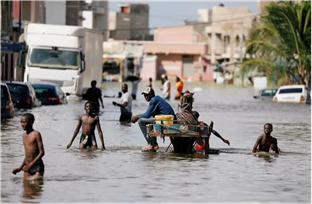
During the second day of the WWF the UNESCO side-event “Flood and drought risk management in Africa” took place in the UNESCO-IHP Pavilion. During the session Prof. Koike Toshio, Deputy Director of the International Centre for Water Hazard and Risk Management (ICHARM), explained the activities they have developed during the past years through the Water Disaster Platform to Enhance Climate Resilience in Africa project (WADiRE-Africa) which embraces a water disaster platform composed of the Flood Early Warning (FEW), Data Integration Analysis Systems (DIAS), Hazard Mapping and a Contingency Planning.
Prof. Toshio further explained that the project covers the areas of Niger and Volta River Basin (11 countries) in West Africa. Furthermore, the project developed training and educational materials of an e-Learning course of the platform focusing on “Flood Early Warning, Hazard Mapping and Contingency Planning in the Niger and Volta River basins”.
Mr. Justin Sheffield (Princeton Climate Institute and University of Southampton) further explained the previous interventions in Africa through the “Enhancing Climate Services for Improved Water Resources Management in Vulnerable Regions to Climate Change: Case studies from Africa and Latin America and the Caribbean” (CliMWaR).
Prof. Sheffield explained the implementation of Flood and Drought monitoring and EWS platforms through an open web interface in Cameroon, Mozambique, Zimbabwe, South Africa, Malawi and Namibia, including a continental version for the African continent, which are all accessible at http://hydrology.soton.ac.uk/apps. Future work will be developed in Save-Busi catchments, located between Zimbabwe and Mozambique, and the combination of satellite information and model-based estimates to the forecasts.
The session continued with a discussion panel regarding the experience of the use and training on the implemented tools and platforms by the two projects moderated by Mr. Koen Verbist, UNESCO Natural Sciences Programme Specialist.
Ms. Paulina Mufeti, Hydrologist at the Ministry of Agriculture, Water and Forestry of Namibia, explained the implementation of the Flood and Drought monitor in Namibia complemented by a virtual workshop on climate forecasting and the use of the platform. Ms. Mufeti highlighted how the platform will be embedded in the Draft Strategy of Integrated Flood and Drought Management, and the future work they would like to do to involve citizens and stakeholders in the provision of water-related information and future initiatives such as a Community Flood and Drought monitoring and Early Warning.
Mr. Slaifou Dene, Senior IT at the Volta Basin Authority in Burkina Faso, talked about the experience of the training for the Volta Basin and the Niger Basin authorities. He highlighted that the platform developed by ICHARM is really useful but since they face an issue of data collection and data probability.
Mr. Gerald Mundondwa, Hydrologist of the Ministry of Lands, Agriculture, Water, Fisheries& Rural Resettlement of Zimbabwe, highlighted the importance of the Monitor platform when dealing with water hazards. He further mentioned the possibility of implementing an alike platform for a shared basin between Zimbabwe and Mozambique.
Urban flooding management and urban hydrology were highlighted as key topics to address by Mr. Mundondwa, and how it would be useful to have tools that could focus on these issues. He also stressed the importance of the interaction between the platform users and developers to enhance this kind of tools.
The three panelists highlighted the importance of education and communication strategies destined to decision-makers and stakeholders concerning Flood and Drought management. They further mentioned the importance of making the information and data accessible and understandable for these groups, and to link it into issues or aspects that are of main importance to them, such as economic or social facts (e.g., life losses or property damage).
The testimonies and experiences of all panelists and speakers were of great importance to understand the implementation and development of Flood and Drouth Monitor Platforms and the linkage between users and decision makers.